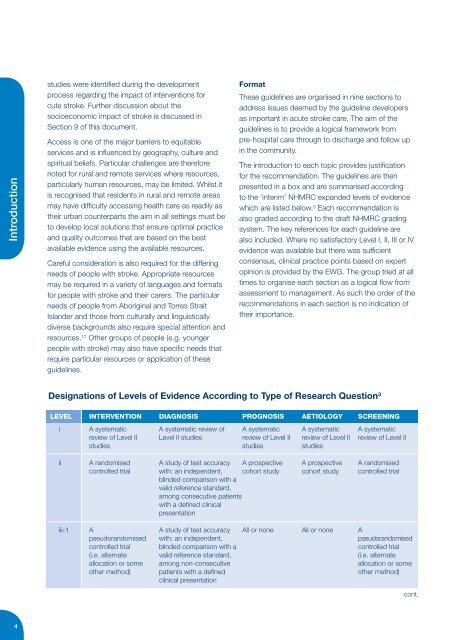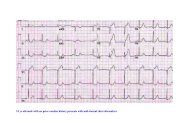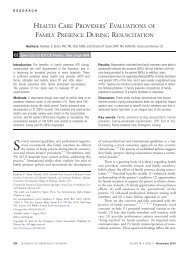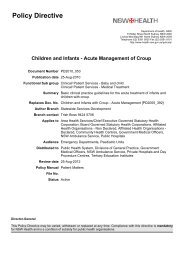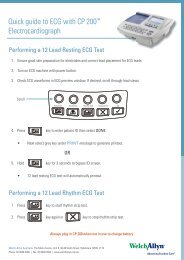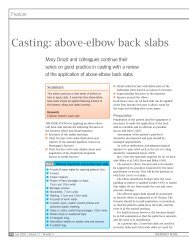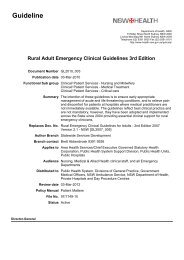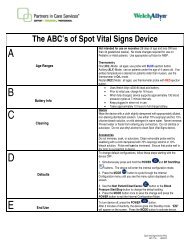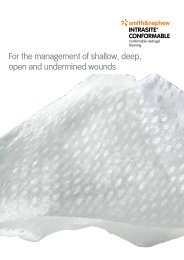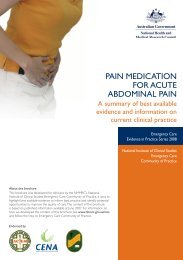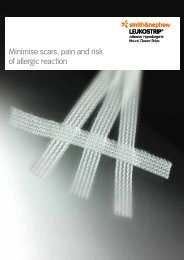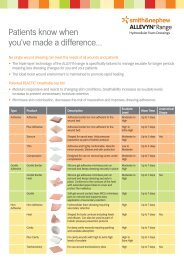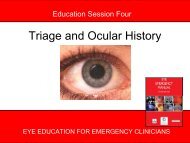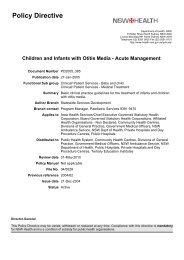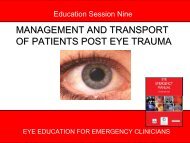Clinical Guidelines for Acute Stroke Management - Living on the EDge
Clinical Guidelines for Acute Stroke Management - Living on the EDge
Clinical Guidelines for Acute Stroke Management - Living on the EDge
Create successful ePaper yourself
Turn your PDF publications into a flip-book with our unique Google optimized e-Paper software.
4Introducti<strong>on</strong><br />
studies were identified during <strong>the</strong> development<br />
process regarding <strong>the</strong> impact of interventi<strong>on</strong>s <str<strong>on</strong>g>for</str<strong>on</strong>g><br />
cute stroke. Fur<strong>the</strong>r discussi<strong>on</strong> about <strong>the</strong><br />
socioec<strong>on</strong>omic impact of stroke is discussed in<br />
Secti<strong>on</strong> 9 of this document.<br />
Access is <strong>on</strong>e of <strong>the</strong> major barriers to equitable<br />
services and is influenced by geography, culture and<br />
spiritual beliefs. Particular challenges are <strong>the</strong>re<str<strong>on</strong>g>for</str<strong>on</strong>g>e<br />
noted <str<strong>on</strong>g>for</str<strong>on</strong>g> rural and remote services where resources,<br />
particularly human resources, may be limited. Whilst it<br />
is recognised that residents in rural and remote areas<br />
may have difficulty accessing health care as readily as<br />
<strong>the</strong>ir urban counterparts <strong>the</strong> aim in all settings must be<br />
to develop local soluti<strong>on</strong>s that ensure optimal practice<br />
and quality outcomes that are based <strong>on</strong> <strong>the</strong> best<br />
available evidence using <strong>the</strong> available resources.<br />
Careful c<strong>on</strong>siderati<strong>on</strong> is also required <str<strong>on</strong>g>for</str<strong>on</strong>g> <strong>the</strong> differing<br />
needs of people with stroke. Appropriate resources<br />
may be required in a variety of languages and <str<strong>on</strong>g>for</str<strong>on</strong>g>mats<br />
<str<strong>on</strong>g>for</str<strong>on</strong>g> people with stroke and <strong>the</strong>ir carers. The particular<br />
needs of people from Aboriginal and Torres Strait<br />
Islander and those from culturally and linguistically<br />
diverse backgrounds also require special attenti<strong>on</strong> and<br />
resources. 17 O<strong>the</strong>r groups of people (e.g. younger<br />
people with stroke) may also have specific needs that<br />
require particular resources or applicati<strong>on</strong> of <strong>the</strong>se<br />
guidelines.<br />
Format<br />
These guidelines are organised in nine secti<strong>on</strong>s to<br />
address issues deemed by <strong>the</strong> guideline developers<br />
as important in acute stroke care. The aim of <strong>the</strong><br />
guidelines is to provide a logical framework from<br />
pre-hospital care through to discharge and follow up<br />
in <strong>the</strong> community.<br />
The introducti<strong>on</strong> to each topic provides justificati<strong>on</strong><br />
<str<strong>on</strong>g>for</str<strong>on</strong>g> <strong>the</strong> recommendati<strong>on</strong>. The guidelines are <strong>the</strong>n<br />
presented in a box and are summarised according<br />
to <strong>the</strong> ‘interim’ NHMRC expanded levels of evidence<br />
which are listed below. 3 Each recommendati<strong>on</strong> is<br />
also graded according to <strong>the</strong> draft NHMRC grading<br />
system. The key references <str<strong>on</strong>g>for</str<strong>on</strong>g> each guideline are<br />
also included. Where no satisfactory Level I, II, III or IV<br />
evidence was available but <strong>the</strong>re was sufficient<br />
c<strong>on</strong>sensus, clinical practice points based <strong>on</strong> expert<br />
opini<strong>on</strong> is provided by <strong>the</strong> EWG. The group tried at all<br />
times to organise each secti<strong>on</strong> as a logical flow from<br />
assessment to management. As such <strong>the</strong> order of <strong>the</strong><br />
recommendati<strong>on</strong>s in each secti<strong>on</strong> is no indicati<strong>on</strong> of<br />
<strong>the</strong>ir importance.<br />
Designati<strong>on</strong>s of Levels of Evidence According to Type of Research Questi<strong>on</strong> 3<br />
LEVEL INTERVENTION DIAGNOSIS PROGNOSIS AETIOLOGY SCREENING<br />
i A systematic A systematic review of A systematic A systematic A systematic<br />
review of Level II Level II studies review of Level II review of Level II review of Level II<br />
studies studies studies<br />
ii A randomised A study of test accuracy A prospective A prospective A randomised<br />
c<strong>on</strong>trolled trial with: an independent, cohort study cohort study c<strong>on</strong>trolled trial<br />
blinded comparis<strong>on</strong> with a<br />
valid reference standard,<br />
am<strong>on</strong>g c<strong>on</strong>secutive patients<br />
with a defined clinical<br />
presentati<strong>on</strong><br />
iii-1 A A study of test accuracy All or n<strong>on</strong>e All or n<strong>on</strong>e A<br />
pseudorandomised with: an independent, pseudorandomised<br />
c<strong>on</strong>trolled trial blinded comparis<strong>on</strong> with a c<strong>on</strong>trolled trial<br />
(i.e. alternate valid reference standard, (i.e. alternate<br />
allocati<strong>on</strong> or some am<strong>on</strong>g n<strong>on</strong>-c<strong>on</strong>secutive allocati<strong>on</strong> or some<br />
o<strong>the</strong>r method) patients with a defined o<strong>the</strong>r method)<br />
clinical presentati<strong>on</strong><br />
c<strong>on</strong>t.


